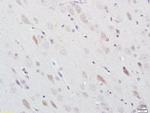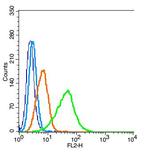Search Thermo Fisher Scientific
FIGURE: 1 / 2
Nitrotyrosine Antibody (BS-8551R) in IHC (P)


Product Details
BS-8551R
Species Reactivity
Host/Isotype
Class
Type
Immunogen
Conjugate
Form
Concentration
Purification
Storage buffer
Contains
Storage conditions
Shipping conditions
Target Information
Nitrotyrosine is a relatively stable product formed from various reaction pathways. Perhaps most notable is the reaction of peroxynitrite (formed from superoxide and nitric oxide (NO) radicals) with tyrosine. As a strong oxidant and nitrating agent, peroxynitrite mediates tyrosine nitration reactions on proteins resulting in inactivation of certain housekeeping enzymes (e. g., alpha1-antiproteinase) as well as endogenous antioxidant enzymes such as catalase and superoxide dismutase (SOD). Nitrotyrosine has been identified as an indicator of cell damage and inflammation, as well as of the production of NO. It is believed that measuring the concentration of nitrotyrosine will serve as a marker for damage caused by NO in the cell. Nitrotyrosine has been implicated in the pathogenesis of several inflammatory, infectious, and degenerative human diseases, such as Alzheimer's and Parkinson's disease, multiple sclerosis, amyotrophic lateral sclerosis (ALS), asthma, atherosclerosis, and a variety of conditions precipitated by endothelial injury. At the protein level, tyrosine nitration can lead to loss or alteration of protein function, as demonstrated for the oncogenic protein p53 and the mitochondrial protein, manganese-dependent superoxide dismutase (MnSOD).
For Research Use Only. Not for use in diagnostic procedures. Not for resale without express authorization.
References (0)
Bioinformatics
Protein Aliases: Nitro-tyrosine

Performance Guarantee
If an Invitrogen™ antibody doesn't perform as described on our website or datasheet,we'll replace the product at no cost to you, or provide you with a credit for a future purchase.*
Learn more
We're here to help
Get expert recommendations for common problems or connect directly with an on staff expert for technical assistance related to applications, equipment and general product use.
Contact tech support
